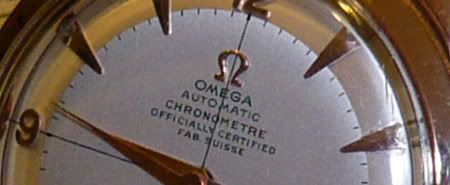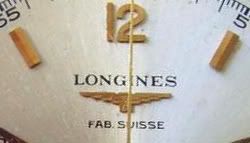 Marv
356
Marv
356

For consumer protection
Jun 14, 2011,18:38 PM
There was a French law (Art 15. de la loi du 11 janvier 1892) that said that it was prohibited to import into France any product whose brand, name, sign or mark could mislead the consumer in the sense that it could be understood as having been produced in France whereas it was not the case.
In 1924, a very strict interpretation of that law applied: a brand name that had a "French" origin or meaning could be considered on its own as a misleading mark! Even brand with a foreign name but with one subsidiary in France were concerned! Therefore, many swiss brands were concerned by this strict rule.
In order to be allowed to import watches into France, many swiss watchmakers had to add a "legal rider" on the dial to explicitely mention the swiss origin: "Importé de ...", "Fabriqué en ...". There was a tolerance for the watches whose dial was too small to have the whole rider printed. In that case, the short "Fab. Suisse" was accepted.
You will find below a dial of a 1934 Reverso.

In 1936, in the document linked by Nickd, another restriction was made: the rider for watches had to be placed very close to the brand name, and not at 6 o'clock any more.

Hereafter is the dial of my Omega T17. circa 1936

This French specificity continued to be valid in the following decades.
Below my reverso post-1937

Please note that there is enough space for the full "Fabriqué en Suisse" below Jaeger-Lecoultre.
Seamaster from 1953

Futurematic from the 50s

And finaly a Longines from the 60s

Now, concerning the date when the "Fab. Suisse" ended, I am not sure it can be precisely established.
The law that protects customers against misleading marks on a product has never been abrogated (cf current Art. 39 Code des Douanes)
... But there has been more and more tolerance: To be considered as misleading, the marks displayed on the product must be really misleading. And even in that case, there is more flexibility regarding the rider and where to place it : e.g. the use of Acronyms or english expressions such as "made in ..." is now fully accepted.
In parallel, the country of origin has moved from the field of "customs" to the field of "marketing". Custom constraints have been reduced from the 60s (Kennedy Round, EEC-Switzerland agreements) whereas the use of the "Swiss Made" label has been strongly marketed.
Regards,
Comments:
view entire thread
"Fab. Suisse" (as well as "Swiss" or "Swiss Made")??
By: Jeff Stein : June 13th, 2011-15:06
Can anyone answer the question as to why certain dials are marked "Fab. Suisse", even though they already have the marking "Swiss" or "Swiss Made"? Was there a specific legal requirement, for watches being sold in France, that the "Produced in Switzerland...
I am not sure if it was a legal...
By: mac_omega : June 13th, 2011-23:34
Hi, I am not sure if it was a legal requirement... but I know "Fab. Suisse" is found only on watches which were imported to France. just my 2 cent erich
A legal protection of description like "Swiss made" ....
By: Marcus Hanke : June 14th, 2011-07:59
... was brought into force only in 1971, and covers all kinds of indications of origin, be they German "Schweiz", "Schweizer Produkt", English "Swiss", "Swiss made", or french "Suisse" , "Fabriqué en Suisse". So all those designations indicate the same. T...
Still Struggling to Understand This One (1962)
By: Jeff Stein : June 14th, 2011-08:17
I am still struggling to explain the "Fab. Suisse" marking on this Autavia dial, from 1962 / 63. Or the Carrera from 1968 / 70? Why the "Fab. Suisse" in the same hand / style as the "Swiss"? Jeff...
I would guess ...
By: Marcus Hanke : June 16th, 2011-23:24
... that these watches have been exported from Switzerland to France, as suggested below. Apparently, France once had a specific rule for the designation of product origin, not accepting English inscriptions (Swiss). Regards, Marcus
I was thinking of...
By: mac_omega : June 14th, 2011-11:06
Hi Marcus, I was thinking of vintage watches well before 1970... was there any legal protection before the date you mentioned. I have watched "Fab. suisse" mainly on vintage Omegas as this my main subject when collecting watches. regards erich
Omega's Use of Fab Suisse
By: Jeff Stein : June 14th, 2011-11:19
I have not studied this in any depth at all, but I recall that Omega seemed to be fond of the "Fab Suisse" marking, inside the caseback and maybe on the movement (but rarely or never on the dial). Longines also seemed to use the mark frequently, over an e...
I am talking about...
By: mac_omega : June 14th, 2011-12:37
Hi Jeff, I am talking about the dial, not the case! "Fab. suisse" on the dial of vintage Omegas I could find only on watches which were imported to France. regards erich
You owe me a beer
By: nickd : June 14th, 2011-14:02
Did some digging as this has intrigued me as well. Getting there slowly. doc.rero.ch ,25,18,19360219.pdf News letter of la Federation Horlogere Suisse , 19 Februrary 1936 My rough translation (parts of it are a pig to translate ) Customs Label "Fab. Suiss...
Free Beer for You . . . in Atlanta!!
By: Jeff Stein : June 14th, 2011-14:58
Absolutely . . . I owe you a cold beer, or two, in Atlanta, Georgia. In all seriousness, I posted this question on three forums -- TimeZone vintage and Chronocentric / OnTheDash vintage Heuer forum being the other two -- and it's great to see that you hav...
For consumer protection
By: Marv : June 14th, 2011-18:38
There was a French law (Art 15. de la loi du 11 janvier 1892) that said that it was prohibited to import into France any product whose brand, name, sign or mark could mislead the consumer in the sense that it could be understood as having been produced in...
Huge Thanks for This Fantastic Posting
By: OnTheDash : June 14th, 2011-21:54
Marv: huge thanks for this fantastic piece of research and writing, to you and all the other contributors to this thread. With your permission, I would love to convert your posting into a webpage, so that it will be available for people trying to figure o...
Thank you for your nice words
By: Marv : June 14th, 2011-22:57
And you can of course convert it into a webpage. There should be no problem with the rights. Pics used to illustrate are photos of my watches - except the first illustration that is extracted from a vintage Ad. Could you please highlight the great resourc...
Consumer protection, customs tariffs or protectionism?
By: nickd : June 14th, 2011-23:32
HI Marv, Excellent post! I followed up on the 1892 text you mention, and it's part of the law on customs tariffs. Later comments on it mention that it's to prevent customs fraud and protect French industry as much as to protect the consumer, and Swiss cri...
As close to the brand as possible
By: Ginger : June 14th, 2011-20:27
A ladies' Jaeger - probably 40s. The band is 12mm at the lugs, so this is a small watch, but evidently not so tiny as to preclude complying with the letter of French law. Ginger...
I Have Created a Blog Posting (Webpage) to Capture This Information
By: Jeff Stein : June 19th, 2011-06:38
I have created a blog posting / webpage, to capture Marv's message, in a more permanent format. http://www.onthedash.com/thoughts/the-fab-suisse-marking-on-watch-dials/ Many thanks Marv, nickd, and all who provided information. Jeff





















